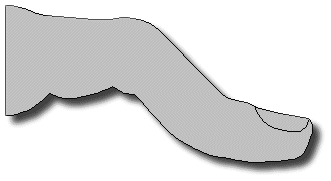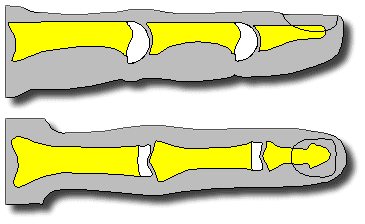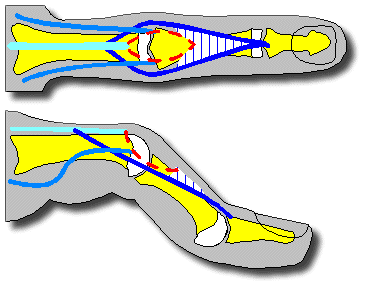| What is it? |
-
The boutonniere deformity refers to a finger which is bent in a particular
way: bent
down at the middle joint and bent back at the end
joint:
|

| What caused it? |
-
This is usually due to an injury, although it can develop in inflammatory
disorders such as rheumatoid arthritis .
Also, some people are born with a mild boutonniere posture of most or all
of their fingers.
-
Here's how the problem happens as a result of injury. The finger bones
and joints are shown here:

-
The tendons which straighten these joints are a bit complicated. They are
like strings running from the the sides and the back of the finger to a
sheet on the top of the finger.

-
When the finger is hit or bent forcefully in just the wrong way, the sheet
on the top of the finger (the central slip of tendon) tears away from its
attachment to the top of the middle finger bone.

-
The tear in the tendon sheet looks like a buttonhole ("boutonniere" in
French), and the end of the finger bone actually begins to stick through
the hole. As a result, the tendons can't straighten the middle joint (which
stays bent) and all of the force of the tendons bypasses the middle joint
and goes to the end joint (which flips backward).

-
The problem can also result from a cut on the back of the finger. The tendon
is right under the skin as it passes over the middle knuckle.
|
| What can you do to help? |
-
Well, there's really not much in the way of self treatment. A finger splint
is helpful, but it has to be made and used in the right way, or it may
make things worse. The best thing you can do is have the problem looked
at by a professional.
|
| What can a therapist do to help? |
-
The mainstay of treatment is therapy. A therapist can make a custom boutonniere
splint to help bend the end joint down and straighten the middle knuckle.
This type of splint may need to be worn for six to eight weeks. In most
cases, proper splinting can avoid the need for surgery.
|
| What can a doctor do to help? |
-
Confirm that this actually is the problem.
-
Prescribe hand therapy and a custom prescription splint.
-
Perform surgery to reconstruct the attachment of the tendons. Results of
surgery are best when the deformity can be stretched out with therapy so
that the finger is limber. If the joints get stiff so that the the finger
can't be fully straightened or bent, surgery is not likely to provide a
satisfactory result. After surgery, therapy and further splinting is needed
for several months.
|
| How successful is treatment? |
-
With proper therapy and effort on the part of the patient, this problem
is improved to a tolerable level most of the time - the finger may not
be as it was before the injury, but it will work well enough to do what
it needs to.
-
Surgery is best reserved for fingers which are limber but just can't straighten.
Surgery is less likely to be successful for a stiff or fixed boutonniere
deformity. Even so, surgery may be a long run for a short slide, and should
be undertaken only after at least one in depth discussion with the surgeon
regarding therapy requirements and outcome expectations with the surgeon.
|
| What happens if you have no treatment? |
-
The biggest problem is that the deformity can worsen gradually over a period
of weeks after the initial injury.
-
However, there is a limited period of time during which treatment of any
sort can help. If treatment is delayed for a month or two, therapy and
splinting is much less likely to bring a permanent improvement. If the
joints are allowed to become stiff, results are even worse.
-
Many people don't have any treatment at all, thinking they just have a
"jammed finger". By the time that it becomes clear that the problem is
not going to improve on its own, it may be too late to do anything about
it. In many people, the problem looks worse than it is - the finger looks
strange, but works pretty well.
|
|





